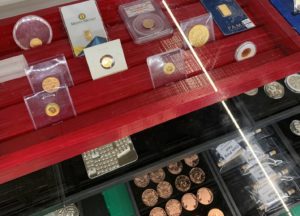Through six of the last eight U.S. recessions, gold outperformed the S&P 500 by an average of 37%. While physical gold is a well-known, safe-haven asset that investors flock to during turbulent times, in traditionally stable financial markets like the U.S., it’s also the ultimate asset in times of essentially any crisis. These crisis situations can range from episodes in which fiat currencies collapse, to times in which gold buys safe passage across international borders, and even to periods where only gold can ensure survival. History is full of examples where gold is the ultimate asset in times of crisis, where gold always comes to the rescue, and where gold provides its holders with choice and freedom – choices and freedoms that are not available to those who do not hold it. Often seen today as an outdated strategy for wealth protection, a brief history lesson of not ancient but recent history, in some cases even events ongoing right now, outline how gold still stands as a crucial part of any preparedness plan. We’ll outline some examples below of gold in crises, which all illustrate why gold is the premiere monetary asset that is universally trusted and recognized, why gold is the best asset for worldwide liquidity and purchasing power during emergencies, and in short, why physical gold is the only asset that can truly provide economic freedom and liberty when confidence in all else fails.
Following the Vietnam War, the Fall of Saigon, and Vietnam’s reunification in 1976, the southern part of Vietnam experienced a mass exodus of people driven by a crippled economy, government discrimination, and forced departures; hundreds of thousands of Chinese and Vietnamese fled to other parts of Asia over both land and sea, an exodus which peaked in 1978-1979. Those refugees fleeing by sea sometimes did so in large ships organized by smugglers, and often with the support of the Vietnamese communist government. An exit route on these ships was only assured for those who could pay these smugglers and corrupt government officials what they demanded: a little over 1 troy ounce of 24 karat gold for an adult, and half that for a child. These gold payments were often in the form of traditional Kim Thanh gold bars, and while these bars were popular in Vietnam, crucially they were recognized and accepted across all Southeast Asia as portable wealth. For those refugees who did not have their gold in the form of these recognized bars, but instead in the form of watches, rings, and other gold jewelry, they still were able to utilize the valuable commodity to purchase safe passage to freedom. This was evidenced by the Hong Kong gold markets being flooded with Vietnamese gold in every form, beginning in 1979. Refugees from Vietnam who took huge risks to escape to a better life could only do so because they had physical gold to buy those escapes, because gold is the universal currency that can be sold almost anywhere to help finance a new life.

Beyond providing safe passage, gold also provides the ultimate haven for wealth during periods of hyperinflation, economic stagnation, currency collapses, and virtually any widespread economic disasters. These types of events are sadly all too familiar for the majority of Argentinians in South America’s third largest economy; lurching from one economic crisis to the next, at times the economic history of Argentina can appear to be a long-drawn-out car crash of hyperinflationary events, currency collapses, debt crises, and general market panic. Argentinians unfortunately are accustomed to this type of drama, having seen years of high inflation, hyperinflation in 1989-1990, a severe economic crisis in 2001-2002, and many instances of rapid loss of value and confidence in their currency. For example, during the hyperinflationary period in 1989, prices in Argentina rose by an annualized 500%. During the 2001-2002 crisis, the peso lost three-quarters of its value while bank accounts across Argentina were frozen. With the local population accustomed to rapidly escalating prices, evaporating savings, and a plummeting peso, Argentinians have on several occasions done what everyone across the world eventually does when confronted with this same problem: they bought gold.
When prevented from buying currencies such as the US dollar due to government-imposed capital controls, banking restrictions, or bank account freezes, Argentinians took the only available option – they flocked to buy physical gold as a form of saving and wealth preservation, buying locally refined gold bars and coins from banks such as Banco de la Ciudad in Buenos Aires. Popular coins included Mexican and Chilean gold bullion coins, South African Krugerrands, and British gold Sovereigns. Since they are now accustomed to economic crises, Argentinians also continue to hold gold items such as rings, watches, and jewelry as a form of savings. They have learned the hard way that when prices are spiraling and the currency is collapsing, gold is one of the few things that keeps its value. As gold’s value in the local peso adjusts upwards, gold holders can readily sell their gold when needed in such informal gold trading districts as Libertad Street in Buenos Aires. Even today, with their peso losing almost 90% of its value, as compared to the U.S. dollar, and reignited inflation, Argentina could soon be on the verge of another crisis; however, one can only hope that as much as Argentinians are used to crises and inflation by now, they have become accustomed to holding physical gold, as a way of stocking emergency funds and preserving their accumulated wealth.
One place which is not on the verge of a crisis, since it’s actually in one, is the fellow South American nation of Venezuela. Marked by a collapsing currency, hyperinflation, banknote scarcity, social unrest, and shortages of essentials, gold has replaced paper currency across most aspects of Venezuelan’s economic life: as a means of payment, a form of barter, and in some cases, literally for day-to-day survival. Sometimes it’s a direct exchange of gold for goods or food, but in Venezuela, gold is also money – in the capital of Caracas, citizens flock to the gold dealers who trade on the streets. Also, amid the hyperinflation and rapid price rises, even previously well-off citizens are now forced to sell their valuable gold jewelry in neighboring Columbia. For example, in the country’s western states of Táchira, Zulia, and Trujill near the Columbian border, thousands of Venezuelans swarm into Columbia daily to sell their gold for a better and more certain price in Columbian pesos than they would get in the constantly inflating and worthless Venezuelan bolivar. Across in the east of Venezuela in the industrial centers of Puerto Ordaz and Guayana City, which is the gateway to the Arco Minero del Orinoco gold mining area, the entire economy has now switched to gold, as the illegal artisanal gold mines in the region flourish and trust in the Venezuelan bolivar has vanished. Even purchasing property in Venezuela or paying tuition at local universities like Puerto Ordaz is now often paid for in gold. In summation, the fiat currency of the bolivar has died as the economy has collapsed, and gold has emerged to perform the role that it has performed for thousands of years, as the trusted form of money and a real form of wealth.

Our final example where hyperinflation reared its ugly head is in another troubled economy, Zimbabwe. Ravaged by dictatorship, corruption, election fraud, and economic collapse, the failed state of Zimbabwe has come to represent one of the world’s best-known cases of modern hyperinflation during famine and food shortages. After years of economic mismanagement and uncontrolled government expenditure, Zimbabwe spun into official hyperinflation in 2007 due to the classic cause of money printing followed by more money printing. By mid-2008, Zimbabwe’s annual inflation rate had reached 250,000,000%, and between 2007 and 2008 the Zimbabwean dollar lost 99.9% of its value. In such a hyperinflationary environment, the wealth and savings of ordinary Zimbabweans, who hadn’t much to begin with, were totally wiped out, with spiraling prices and resulting price controls leading to real hardship in the form of food shortages and even famine. Due to the collapsed local currency, the Zimbabwean economy had to adapt to barter and trade in foreign currencies and in gold, with food suppliers in many places only accepting gold. Although a gold resource rich country, Zimbabwe’s local population, which on the whole did not have any experience or inclination to hold gold as a survival mechanism, found themselves forced to resort to illegal gold mining in disused mines, or panning for gold in rivers just to acquire even tiny quantities of gold to trade for food.
Although each of the above examples are different, they all illustrate the power of gold in times of crisis: a universal currency that is always accepted, and a universal asset that is borderless, liquid, and portable. In Vietnam, gold bought freedom of passage across international borders, with refuges using portable gold wealth to pay fares and as emergency money to start new lives. In Argentina, Venezuela, Zimbabwe and Vietnam, physical gold was a haven and financial insurance for those that had the foresight to hold it. Gold fulfilled its role of saving for those who had held it, a role that fiat currencies utterly failed, and it remained a medium of exchange in all these situations, when trust in paper currencies had died. The causes may differ – hyperinflation, death of paper currencies, economic mismanagement, or capital controls, but the outcome is always the same. People and economies instinctively turn to the ultimate asset, gold, as a safe harbor during a crisis, because only gold always persists as a store of value and a trusted a medium of exchange.
Neither Norman C. Williams IV or Practical Preppers LLC provide investment, tax, legal or accounting advice. This material is for informational purposes only, and is not intended to provide, and should not be relied on for investment, tax, legal or accounting advice. You should consult your own investment, tax, legal and/or accounting advisors before engaging in any transaction.











